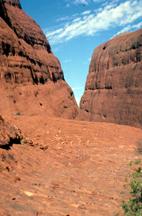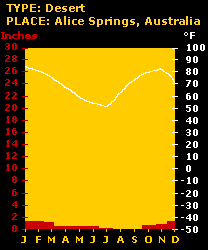|
 Desert Desert
The defining characteristic
of a desert is that it is dry. Depending on its geographical location,
the annual precipitation in a desert varies from half an inch to
as much as 15 inches. Rainfall is usually very localized, and although
it is frequently seasonal, it is difficult to predict when or where
it will occur. At times in the Atacama Desert in Chile, years have
passed with no measurable rainfall at all. However, that is not
generally the case. Photo
© 2000-www.arttoday.com
Deserts can be either
hot such as the Australian Desert or cold such as the Gobi Desert.
As with all biomes, the desert climate is determined by geographic
conditions. Geographic conditions such as location, high atmospheric
pressure, and proximity of mountain ranges determine just what type
of desert it is.
Deserts may occur along
the coast such as the Atacama and Namib deserts or in the interior
of continents such as the Great Basin and Australian deserts, which
are far from any source of water. Coastal deserts are located on
west coasts of continents between 20° to 30° latitude. Prevailing
winds blow in an easterly pattern and prevent the moisture from
moving onto the land. Semiarid deserts, like the Great Basin Desert,
are not only located far from moisture, but are frequently associated
with high mountain ranges that produce a rainshadow effect. The
rainshadow effect prevents available moisture from reaching the
area. The great Gobi Desert of Mongolia has little rainfall because
the Himalayan Mountains prevent rainfall from moving into this region.
Because all deserts are
dry, they have large daily temperature variations. Temperatures
are high during the day because there is very little moisture in
the air to block the Sun's rays from reaching Earth. Once the Sun
goes down, the heat absorbed during the day quickly escapes back
into space. High daytime temperatures and low nighttime temperatures
make survival in the desert very difficult.

Back
| Next
|











